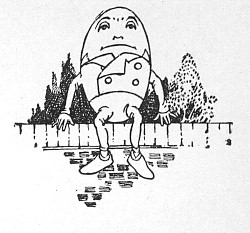
Image via Wikipedia
My girlfriend pointed out this interesting tidbit that was posted on Yahoo! today. We always visualize Humpty Dumpty as an egg, and yet nowhere in the rhyme itself is he described as such. Yahoo! Answers provides some insight:
Indeed the rhyme
Humpty Dumpty sat on a wall,
Humpty Dumpty had a great fall.
All the king’s horses and all the king’s men
Couldn’t put Humpty together again….does not tell us at all that
Humpty was an egg. However its etymology has a number of variations,
and it was in Lewis Carroll’s 1871 book “Through the Looking Glass”
(that used this rhyme), where the book’s illustrator John Tenniel first
drew Humpty as an egg, sitting on a wall.
An 1810 version of the rhyme also does not explicitly state that the
subject is an egg because it was originally posed as the riddle as such:
Humpty Dumpty sate on a wall,
Humpty Dumpty had a great fall;
Threescore men and threescore more,
Cannot place Humpty dumpty as he was before.
Furthermore, “humpty dumpty” was an eighteenth-century reduplicative
(linguistic root) slang for a short and clumsy person.
Pictured is Tenniel’s illustration from Through the Looking Glass. Fascinating stuff – it’s funny how this sort of thing happens.
Interestingly, the Wikipedia page on Humpty Dumpty goes on to detail speculation that Humpty Dumpty may have actually been “a cannon used in the siege of Gloucester in 1643 during the English Civil War” made of brittle metal and used by the Royalist faction. Another possible origin is King Richard III of England,
Shakespeare’s hunchbacked Egg, the ‘Wall’ being either the name of his horse
(called ‘White Surrey’ in Shakespeare’s play) or a reference to the
supporters who deserted him. During the battle of Bosworth Field, Richard
fell off his steed and was said to have been ‘hacked into pieces.’ (Though the play depicts Richard as a hunchback, other historical
sources suggest that he was not.)
